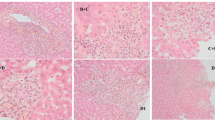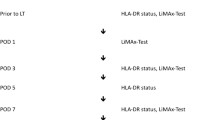Abstract
A four-and-a-half-year-old boy underwent living-donor liver transplantation (LDLT) for progressive familial intrahepatic cholestasis. Immunosuppressive therapy was commenced with tacrolimus and methylprednisolone, despite which derangement of liver function tests (LFTs) became evident on postoperative day (POD) 7. A diagnosis of acute cellular rejection was made and steroid pulse therapy (SPT) was initiated. Although the LFTs improved transiently after SPT, they deteriorated again, and failed to respond to repeated SPT. Jaundice was prolonged and transudative ascitic fluid accumulated. Liver needle biopsies on PODs 20 and 24 confirmed severe graft damage constituting early chronic rejection. Based on the poor response to steroid therapy, coagulopathy, and protein-losing ascites, 3 mg/body weight of muromonab-CD3 was given from POD 24, increasing to 5 mg/body weight from POD 29. A rebound in LFTs appeared after the muromonab-CD3 therapy was discontinued and the LFTs normalized. The ascites and jaundice also disappeared, and the patient’s general condition improved. Liver needle biopsies on POD 47 and 61 confirmed dramatic recovery from severe graft damage.
Similar content being viewed by others
References
Egawa H, Teramukai S, Haga H, Tanabe M, Fukushima M, Shimizu M. Present status of ABO-incompatible living donor liver transplantation in Japan. Hepatology 2008;47:143–152.
Ueda M, Oike F, Ogura Y, Uryuhara K, Fujimoto Y, Kasahara M, et al. Long-term outcomes of 600 living donor liver transplants for pediatric patients at a single center. Liver Transpl 2006;12:1326–1336.
Ogura Y, Kaihara S, Haga H, Kozaki K, Ueda M, Oike F, et al. Outcomes for pediatric liver retransplantation from living donors. Transplantation 2003;76:943–948.
Martin SR, Atkison P, Anand R, Lindblad AS. Studies of Pediatric Liver Transplantation 2002: patient and graft survival and rejection in pediatric recipients of a first liver transplant in the United States and Canada. Pediatr Transplant 2004;8:273–283.
Sakamoto S, Haga H, Egawa H, Kasahara M, Ogawa K, Takada Y, et al. Living donor liver transplantation for acute liver failure in infants: the impact of unknown etiology. Pediatr Transplant 2008;12:167–173.
McGuire BM, Rosenthal P, Brown CC, Busch AM, Calcatera SM, Claria RS, et al. Long-term management of the liver transplant patient: recommendations for the primary care doctor. Am J Transplant 2009;9:1988–2003.
Kim MJ, Yun SH, Chun HK, Lee WY, Cho YB. Post-transplant lymphoproliferative disorder localized in the colon after liver transplantation: report of a case. Surg Today 2009;39:1076–1079.
Todd PA, Brogden RN. Muromonab CD3. A review of its pharmacology and therapeutic potential. Drugs 1989;37:871–899.
Hooks MA, Wade CS, Millikan WJ Jr. Muromonab CD-3: a review of its pharmacology, pharmacokinetics, and clinical use in transplantation. Pharmacotherapy 1991;11:26–37.
Solomon H, Gonwa TA, Mor E, Holman MJ, Gibbs J, Watemberg I, et al. OKT3 rescue for steroid-resistant rejection in adult liver transplantation. Transplantation 1993;55:87–91.
Goldstein G, Kremer AB, Barnes L, Hirsch RL. OKT3 monoclonal antibody reversal of renal and hepatic rejection in pediatric patients. J Pediatr 1987;111:1046–1050.
Joseph JT, Kingsmore DB, Junor BJ, Briggs JD, Mun Woo Y, Jaques BC, et al. The impact of late acute rejection after cadaveric kidney transplantation. Clin Transplant 2001;15:221–227.
Blakolmer K, Jain A, Ruppert K, Gray E, Duquesnoy R, Murase N, et al. Chronic liver allograft rejection in a population treated primarily with tacrolimus as baseline immunosuppression: longterm follow-up and evaluation of features for histopathological staging. Transplantation 2000;69:2330–2336.
Blakolmer K, Seaberg EC, Batts K, Ferrell L, Markin R, Wiesner R, et al. Analysis of the reversibility of chronic liver allograft rejection implications for a staging schema. Am J Surg Pathol 1999;23:1328–1339.
Mazariegos GV, Salzedas AA, Zavatsky J, Sindhi R, Parizhskaya M, McGhee W, et al. Long term management of liver transplant rejection in children. BioDrugs 2000;14:31–48.
Richards JM, Vogelzang NJ, Bluestone JA. Neurotoxicity after treatment with muromonab-CD3. N Engl J Med 1990;323:487–488.
Hirsch R, Gress RE, Bluestone JA. Anti-CD3 antibody for autoimmune disease, a cautionary note. Lancet 1989;1:1390.
Opelz G, Henderson R. Incidence of non-Hodgkin lymphoma in kidney and heart transplant recipients. Lancet 1993;342:1514–1516.
Kimball JA, Norman DJ, Shield CF, Schroeder TJ, Lisi P, Garovoy M, et al. The OKT3 Antibody Response Study: a multicentre study of human anti-mouse antibody (HAMA) production following OKT3 use in solid organ transplantation. Transpl Immunol 1995;3:212–221.
Oguma S, Belle S, Starzl TE, Demetris AJ. A histometric analysis of chronically rejected human liver allografts: insights into the mechanisms of bile duct loss: direct immunologic and ischemic factors. Hepatology 1989;9:204–209.
Gupta P, Kaufman S, Fishbein TM. Sirolimus for solid organ transplantation in children. Pediatr Transplant 2005;9:269–276.
Caballero A, Fernandez N, Lavado R, Bravo MJ, Miranda JM, Alonso A. Tolerogenic response: allorecognition pathways. Transpl Immunol 2006;17:3–6.
Game DS, Lechler RI. Pathways of allorecognition: implications for transplantation tolerance. Transpl Immunol 2002;10:101–108.
Michaels PJ, Fishbein MC, Colvin RB. Humoral rejection of human organ transplants. Springer Semin Immunopathol 2003;25:119–140.
Author information
Authors and Affiliations
Rights and permissions
About this article
Cite this article
Hori, T., Nguyen, J.H. & Uemoto, S. Muromonab-CD3 for the successful treatment of early chronic rejection after pediatric liver transplantation: Report of a case. Surg Today 41, 585–590 (2011). https://doi.org/10.1007/s00595-010-4309-x
Received:
Accepted:
Published:
Issue Date:
DOI: https://doi.org/10.1007/s00595-010-4309-x




